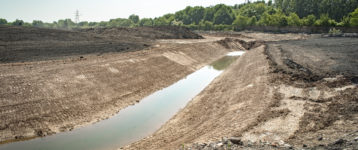When are environmental cleanup methods needed? If you are alarmed by a chemical spill on your land or improper waste disposal, then it is time for environmental remediation efforts. There are several reasons why you would need to call on remediation technologies.
If you have an underground oil tank with a leak, you need to clean up your oil spill. For example, a gasoline leak would lead to hiring soil remediation services. Choose from several environmental cleanup methods and decide which is best for your situation.
6 Environmental Cleanup Methods
While a toxic spill is a reason for alarm, several technologies for soil make it so the soil can still be cleaned and ready for reuse. It is vital to know that the soil does not have to be removed and thrown away all together. Taking quick remedial actions with one of these environmental cleanup methods is sure to solve the problem.
Leaving an environmental spill untreated can lead to several environmental and health issues like:
- Poisonous gas released into the air
- Toxic spills leaking into drinking water
- Hydrocarbons seeping down into groundwater
- Pollution of oceans and waterways
- Stunted growth of plant life on contaminated soil
Enlist a trusted contracting company to take care of your environmental cleanup project by using one of these helpful environmental cleanup methods:
1. Ground Water Pumping and Treatment
When a hydrocarbon spill gets down into the groundwater, there are ways of fixing the problem. So how does the groundwater get contaminated, leading to environmental cleanup methods?
An oil spill that happens from a leaky oil tank can seep all the way through the soil and leak into the contaminating groundwater that lies under the layer of soil. This water is used for irrigation throughout the community and has the potential to harm the health of many people.
Groundwater pumping consists of a vacuum pump that draws out the contaminated water and sends it to a treatment plant. The water is treated by a few environmental cleanup methods, separating the contaminants from the clean water.
The methods include:
- Carbon Absorption: This method involves trapping the carbon and releasing it in a place where it cannot hurt the environment or any human. When the poisonous gas is absorbed out of the groundwater, the water can be tested and deemed worthy to return to its place.
- Biological Treatment: Microorganisms are added to the water in order to consume the hazardous materials and turn the water into clean water again. This treatment can be used while the water is still in the ground, lowering the cost and increasing the convenience of this treatment.
- Air Stripping: This process of circulating air through the groundwater is effective because the toxic chemicals quickly evaporate. When they change from a liquid to a vapor, they are released into the air and no longer remain in the water.
When you use one of these environmental cleaning methods, you can return the clean water back where it can be used to irrigate the land safely. These proven methods can be taken care of by a trusted contracting team like Mikula Contracting.
2. Wastewater Treatment
The treatment technologies used to remediate wastewater are similar to those for groundwater. Wastewater treatment plants turn the water into clean water that can be repurposed. By using physical separation, biological treatments, and chemical remediation, wastewater can be cleansed.
3. Soil Remediation
When petroleum hydrocarbons spill into the soil, environmental cleanup methods are required to cleanse the soil so that it can healthily grow plants and contribute to the environment again. Contaminated soil can harm the environment, plant life, and human health.
It is imperative to treat the soil with one of the environmental cleanup methods immediately after finding out about the problem. It is a health hazard to ignore contaminated soil and allow it to pollute the surrounding areas. In addition, the responsible parties are susceptible to litigation if contaminated soil goes untreated.
The Superfund Program was created to ensure that required environmental cleanup methods are implemented to remedy soil and water after toxic spills. You can contact the program to find answers to your problem and learn about remediation efforts.
4. Incineration
Incineration uses an extremely high temperature to the contaminated sites to burn away the toxic substance in the soil. Then, the soil is taken to a treatment center where the heat is applied. The hauling out of the soil and replacement of the soil is a lengthy step in the process.
Incineration has proven to be an effective method for soil remediation. It can also be applied there at the site, but it is more common for the soil to be hauled away to a treatment center.
5. Thermal Desorption
The removal of contaminated elements in the soil can also be treated with thermal desorption. These high heats are used to burn away toxins like mercury and active hydrocarbons. The liquids are turned into vapors that are contained and properly disposed of.
The vapors can also be removed through the process of afterburning, which burns away the poisonous vapors as well. Thermal desorption is an excellent way to remove contaminants in a treatment center. With a trusted team like Mikula Contracting, you can find out if this is the best method for your remediation issues.
6. Removal and Disposal
The last option of energy cleanup methods is the removal of contaminated substances. And instead of removing the soil or water to take it to a treatment plant, the substance is thrown away. While this method is wasteful and does not promote the reuse of the soil or water, sometimes it is the last resort option.
Disposal requires a few steps. You cannot just throw contaminated soil into your dumpster and hope all is well. Some things to consider are:
- Safety Gear: When loading away contaminated soil, the team must wear the proper safety gear. You cannot hire an ordinary junk removal team. You will need a team that is well-versed in the handling of toxic substances. A contracting team like Mikula Contracting will know how to remove your soil safely.
- Landfills that Accept Hazardous Waste: You will need to research which landfills accept contaminated soil and water. There can be dangers of mixing hydrocarbon-infused soil into an ordinary dump. Follow the proper protocol to ensure your soil is dumped into the right place.
- Disposal for Reuse: Even if you don’t have needs for the soil yourself, you can dispose of the soil to a place that will treat the soil for its own purposes. This way, you can count on the soil getting recycled without having to take part in the process yourself if you do not have a need for reuse.
As with other instances, it is always wise to look into environmental cleanup methods before considering disposal. However, even if you feel like you’ve exhausted all your options, you can call on a team to help you with finding the right environmental cleanup methods.
Consulting with a professional team is the responsible thing today before disposing of the toxic substance altogether. With ongoing cleanup technologies, you can be sure to find the right remediation method for your needs.
In Summary
As you are sifting through environmental cleanup methods, you will find several available options for groundwater, soil, wastewater, and other contaminated substances. While you may not be familiar with which way is best for you, you can be sure to ask your expert contractor about the methods that they have preferred over the years.
Remember to consider these options:
- Groundwater Pumping
- Wastewater Treatment
- Soil Remediation
- Incineration
- Thermal Desorption
- Disposal
You can also look for clues in a great contractor so that you know you can trust them. Look for these aspects in potential contractors for environmental cleanup:
- Experience in remediation: Does the team have ample knowledge of the remediation methods we’ve discussed? Ask challenging questions and test their ability to be sure that they know what they’re talking about before hiring a team for your project.
- Positive reviews: Look up reviews on the company and search for keywords about remediation so you can discover how other customers feel about the company’s remediation efforts. Be careful in weeding out low-star reviews about unrelated issues that won’t affect your project.
- Referrals from friends and family: Ask around friends and family to find out who they’ve used for remediation in the past. You can hear personal accounts of their experiences and decide if you want to go with their suggestions.
- Safety protocols: Does the contracting team take safety seriously? Do they show up with the proper equipment and safety attire? Make sure they are serious about safety.
- Confidence in Answering Questions: If you are meeting with a contracting team, they should prove that they can answer all of your questions confidently. Do not go with a team that skirts around questions or avoids specific topics.
Now you are armed with knowledge and ready to start on your soil remediation. With this information needed to compare and contrast environmental cleanup methods, you are prepared to understand the options that the contractors present.
Environmental Cleanup Contractor in NJ
You can count on Mikula Contracting for various environmental cleanup methods. Do not delay in contacting our trusted company to take care of your toxic waste. The longer you wait, the more damage that can occur. Our team is ready to answer any questions you may have and give a consultation on your project.
Our family-owned company has over 70 years in the business. Our current team has over 200 years of combined experience. You don’t have to worry about common construction mishaps when choosing a trusted company like Mikula Contracting. Contact us today to set up your consultation.



